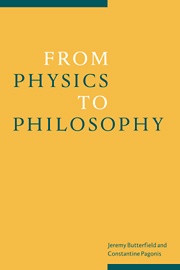Book contents
- Frontmatter
- Contents
- List of contributors
- Preface
- Introduction
- 1 Locality and the Hardy theorem
- 2 Beables in algebraic quantum theory
- 3 Aspects of objectivity in quantum mechanics
- 4 The ‘beables’ of relativistic pilot-wave theory
- 5 Bohmian mechanics and chaos
- 6 Strange positions
- 7 From metaphysics to physics
- 8 Models and mathematics in physics: the role of group theory
- 9 Can the fundamental laws of nature be the results of evolution?
- Bibliography of the writings of Michael Redhead
- Index of names
- Index of subjects
Introduction
Published online by Cambridge University Press: 23 December 2009
- Frontmatter
- Contents
- List of contributors
- Preface
- Introduction
- 1 Locality and the Hardy theorem
- 2 Beables in algebraic quantum theory
- 3 Aspects of objectivity in quantum mechanics
- 4 The ‘beables’ of relativistic pilot-wave theory
- 5 Bohmian mechanics and chaos
- 6 Strange positions
- 7 From metaphysics to physics
- 8 Models and mathematics in physics: the role of group theory
- 9 Can the fundamental laws of nature be the results of evolution?
- Bibliography of the writings of Michael Redhead
- Index of names
- Index of subjects
Summary
Physics is a vast discipline, rich with topics inviting philosophical analysis. In undertaking that analysis, the philosophy of physics can be pursued in different styles. There is a spectrum: ranging from the ‘theorem-proof’ style as used in expounding a piece of mathematical physics (though here the theorems will be motivated by philosophical ideas), through philosophical-cum-physical argument that adverts in detail to pieces of physics (e.g. in displayed equations), to purely philosophical argument that is in some way based on, or influenced by, physics. For the most part, the essays in this collection are examples of the second of these three styles: they aim to combine detailed presentation of some technicalities in theoretical physics with the dialectical rigour of analytic philosophy.
The essays also have, with one exception, a common subject-matter: the philosophy, or if you prefer foundations, of quantum theory. The first six essays fall squarely in that subject-matter. The seventh and eighth broaden the discussion: they address, respectively, philosophical aspects of (i) the search for a theory of quantum gravity, and (ii) quantum theory's use of group theory. The final essay, by Abner Shimony, is much more speculative: it assesses the conjecture that the fundamental laws of nature are products of evolution.
Arthur Fine's essay starts the volume, on a central topic in philosophy of quantum theory: proofs of quantum nonlocality. Fine analyses a proof by Lucien Hardy, which as Fine says, is a characteristic example of a new generation of proofs that apparently make less use of probabilities and thereby dispense with inequalities. However, Fine shows that this appearance is misleading.
- Type
- Chapter
- Information
- From Physics to Philosophy , pp. xi - xviPublisher: Cambridge University PressPrint publication year: 1999



